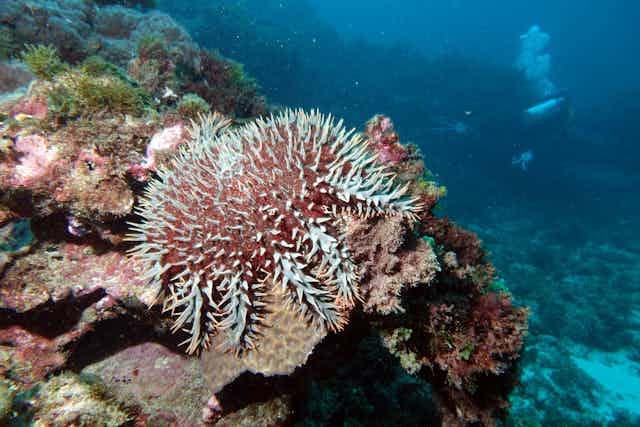In the midst of harsh cuts to Great Barrier Reef management and research, including cuts to the Great Barrier Reef Marine Park Authority and the Australian Institute of Marine Science, the Department of Environment has proposed a new A$40 million Reef Trust.
While the Reef Trust will not compensate the loss of programs, it is a step in the right direction. But it still needs work on its structure and focus. The government released a discussion paper on the trust, which is open for comment until today.
The Reef Trust will be jointly managed by the Department of the Environment and Queensland, with “advice” from the Great Barrier Reef Marine Park Authority, the Australian Institute of Marine Science, and “other agencies.” While the trust does not compensate for the cuts, because it will not fund the staff or the projects that are being cut, it could represent one part of a good finance strategy for the Great Barrier Reef, with a few improvements.
Filling the conservation funding gap
The trust was born from a campaign promise to offer ongoing funding for water quality improvements. The creators are hopeful that it will eventually attract philanthropic donations, and that it will be a smart investment vehicle for offset monies (investments by private developers required by Environmental Protection and Biodiversity Conservation Act approvals).
Globally, we face a massive conservation funding gap. In forthcoming research I have estimated that the gap between what we spend and what we need to spend to conserve biodiversity is US$7 trillion. While there is no Australian breakdown of the figures, we know underfunding of the Great Barrier Reef is substantial, and the Reef Trust may begin to address this deficit.
The Reef Trust has very solid “investment principles,” based on international best practice. But it could still do with some improvements.
Focus on starfish ignores greater threats
The discussion paper states that the focus of the trust will be eradicating crown-of-thorns starfish, improving water quality, and protecting species.
But, while most scientists would agree that water quality improvement and threatened species protection are both vital, few would argue that crown-of-thorns eradication deserves such prominence. In fact, as reef scientist Terry Hughes has argued previously on The Conversation, crown-of-thorns is likely a symptom of human disturbances such as dredging and runoff — and claims that crown-of-thorns have contributed to reef death are based on offshore studies.
Port development and climate change are two of the biggest threats to the health of the Great Barrier Reef, and neither are mentioned once in the discussion paper.
The Reef Trust would be much more likely to improve the long-term health of the Great Barrier Reef if it focused on climate change, port development, as well as water quality improvements within catchments.
The problem with offsets
This leads to the second problem in the Reef Trust. The trust is initially capitalised at $40 million from the Commonwealth government. But it will also accept money from private companies as part of mandatory environmental offsets under the Environmental Protection and Biodiversity Conservation Act.
But combining offsets with other sources of funding introduces risks (whether they work at all is another matter). As previously discussed on The Conversation, offsets are intended to compensate for specific development impacts, not to be used for general reef improvement.
If governments spend money from port development on catchment projects, it introduces the risk and public perception that 1) proponents can pay to damage the reef and 2) that proponent monies might replace core government funding.
In forthcoming research, colleagues and I developed a framework for effective marine offsets for the Great Barrier Reef that outlines how offset monies can be best spent.
Building a fund for the future
In the financial sense, a “trust” is a long-term investment mechanism in which an investor gives assets to a “trustee” for the benefit of a third party.
Conservation trust funds have been established in over 50 countries and they are an important finance mechanism for biodiversity. However, trusts are typically set up as endowments, meaning the monies are invested and only the interest on the investment (averaging 3%) is spent annually. This ensures that funds are available long-term.
There are notable exceptions, such as the Hawaii Fish Trust, which operates as a spend-down fund - all of the money will be invested within ten years - because the conservation needs are too big and urgent to operate under the small income stream of an endowment.
The situation for the Great Barrier Reef is similar, and a spend-down fund might be a good short-term option to finance urgent actions.
But another trust structure that leverages the current political support, while building towards longer-term financing, should be considered: a revolving fund that is structured to both spend and replenish monies through time, allowing immediate action and longer-term sustainability. If some of the monies are distributed through low-interest loans to achieve conservation targets, some of the capital can be recycled for the future.
Who should manage the fund?
In the social sense, “trust” is a belief in the reliability, truth, and dependability of someone or something.
As for who manages the Reef Trust, the public - who is the third party benefactor of this financial trust as they benefit from the Great Barrier Reef - should consider who they trust the most to oversee the investments.
In other parts of the world, funds are often managed by NGO boards that include key government representatives, even when governments are the primary investors. NGO funds also are much more likely to attract philanthropic donations, which has the potential to significantly increase the capital available for Reef projects.
Australia needs a Reef Trust, and we should applaud and support its creation. With some tweaks to focus and structure, it can be a vital part of financing the protection of the Outstanding Universal Value of our Great Barrier Reef.

